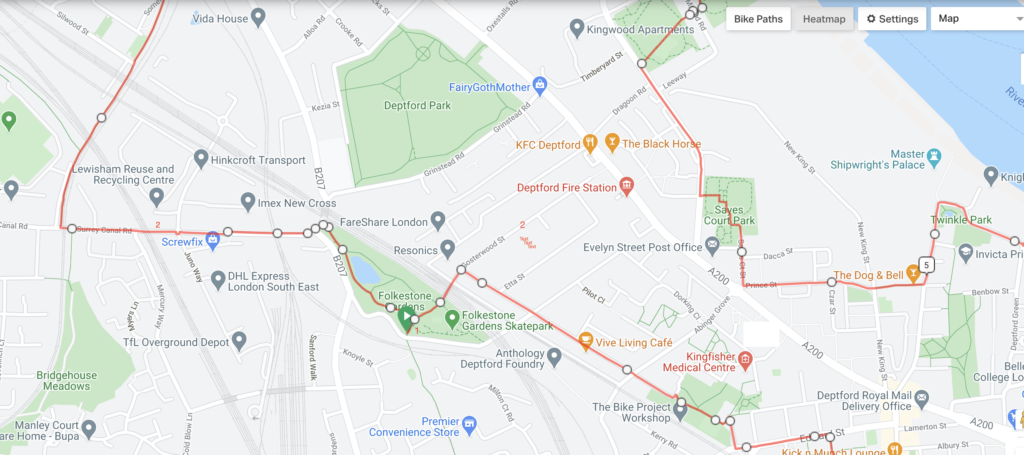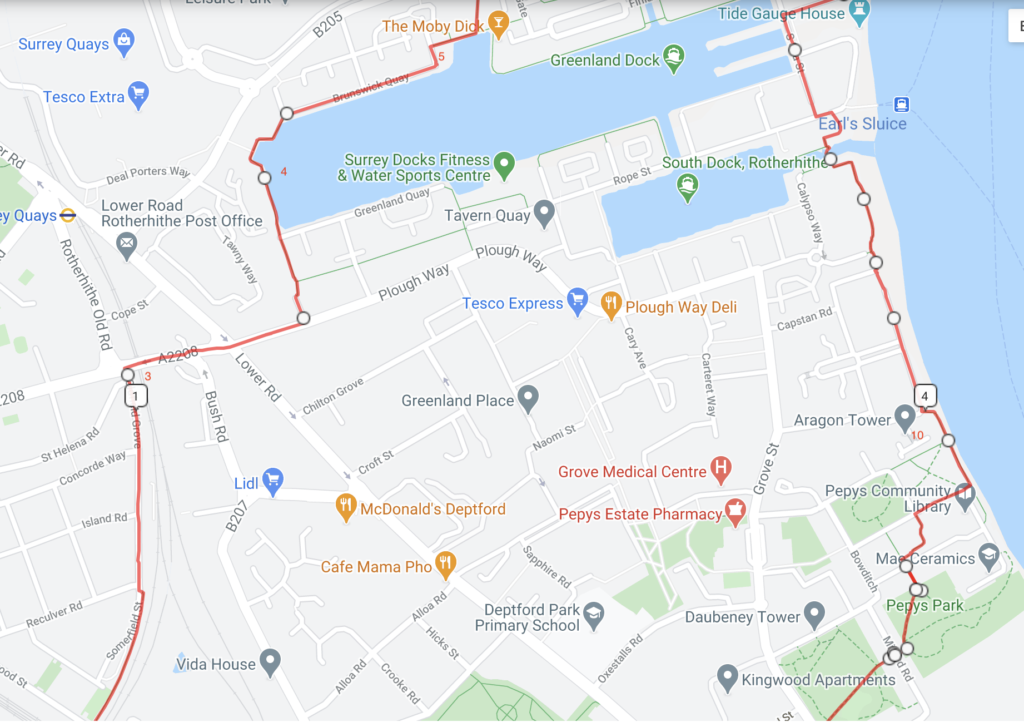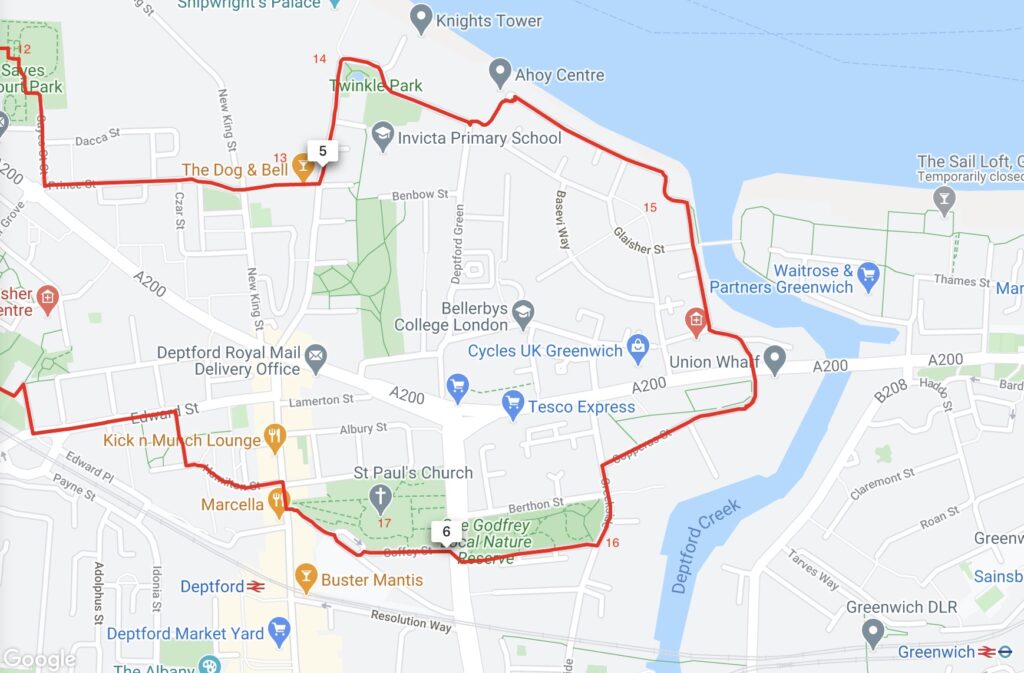A 7 mile circular ride from Deptford, taking in the Surrey Docks, Russia Dock Woodland and Surrey Docks Farm
https://ridewithgps.com/routes/35155982




Notes on the Deptford Surrey Docks Family Ride 7 miles circular. Flat and easy
- The route starts in Folkestone Gardens Park. There are toilets in the cafe. A popular local park and space shared with pedestrians here and on a lot of this route, so make sure to ride carefully, giving way to pedestrians.
- Surrey Canal Rd Cycleway 10 Traffic free but care needed at junctions with roads and industrial unit entrances
- Take care moving on to pavement across Oldfield Rd on to shared space which takes you through two main road crossings on to Plough Way, as occasionally drivers do turn left off main road on to Oldfield Grove.
- Greenland Dock: Take time, especially in Spring, to check out the bird life and the nesting points in the dock. We have seen great crested grebes here, amongst a wide range of other water birds. Theres also a lot of history in this place. There’s been a dock on this site for nearly 500 years. The name Greenland Dock came later, in the 18th century when the whaling ships from Greenland used it. Back then, it would not have been so picturesque. The quayside would have been used to render down the whales blubber into oil, by boiling. It would have been a stinking, smoky, unpleasant place to work in. None would have ventured down here for a gentle quayside stroll back then.
Once the whaling trade declined, timber took over. In the 19th century, Londons growth was huge and fast and the timber trade was huge and profitable. More docks around the Greenland Dock were built, “timber ponds”. Their purpose was to float timber, a way to store it. The timber, already cut into shape, was organized into rafts. Moved by skilled rafters, they could be manoeuvred in that form out onto the Thames. Many of the names that the new docks were given echoed the origin of the timber that ended up in them, Canada Dock, Russia Dock, Norway Dock. Most of them are now filled in and covered by housing, shops and the lovely Russia Dock Woodland, through which this ride takes you.
5. As you ride round the dock, you will pass some iron silhouette sculptures, coloured russet red by rust. These are fairly recent additions and commemorate three people with links to the area. Michael Caine, the actor, who was born nearby, Phyllis Pearsall, a painter who founded the Geographers A to Z company. There was a time when every London home had at least one copy of the London A to Z. The third sculpture is a cormorant perched on a bicycle and is in memory of Barry Mason, a man who lived not far from this dock, loved the area and also loved his bicycle. He campaigned long and hard to keep these areas, and areas like them nationwide, safely accessible to all on foot or by bicycle. The bicycle represents twin passions of his. Those of us who knew him, also knew he would prefer this as a memorial rather than an image of him personally.
6. Drop down to the left off the dock side and head into Russia Dock Woodland. Its easy to get lost on these convoluted paths through this little reserve, but no need to worry. Sooner or later you’ll find yourself back where you need to be and its a pleasant meander anyway.
7. Stave Hill is tucked away behind the greenery, but its worth a visit. It marks another stage in the history of the Surrey Docks, their decline and redevelopment in the 20th Century. Its a 30-foot (9.1 m) high artificial mound. Its worth locking up your cycles for a bit and stepping up to take in the view views over Canary Wharf, the City of London, and much of south and central London; on clear days the view stretches as far as Wembley Stadium. It was created in 1985 by the LDDC, using waste material and rubble from the work done to landscape the former commercial docks
8. You exit the Woodlands by Nelson Dock on Rotherhithe St. The dock is long gone, and you can either ride along Rotherhithe St for a little and head up on to the riverside at Durands Wharf as the map route does.
9. Or there is a way back to the riverside earlier, taking the steep drive up into the Hilton hotel grounds and wiggling round the grounds back to the river from there. Although the riverside development has a number of wiggly barriers between here and Surrey Docks Farm that you have to dismount and walk through.
10. Surrey Docks farm makes a good café stop. Lots to see and toilets available.
Some wiggling off and back to the riverside path required between there to where we meet Greenland Dock again, at its exit point to the Thames.
11. You soon find yourself crossing over the borough boundary back into Lewisham, past Aragon Tower, once social housing, part of the Pepys Estate behind, although sold off decades ago.
Lewishams Riverside was home to the very first national naval dockyards. Not much left visible now, but its naval heritage dates back to the 15th Century, Henry VII beginning the first major development then, carried on by his son. The history of this area is so full and rich, its impossible to cover anything here. If you’re interested, follow up at home. Its fascinating.
12. Sayes Court Park itself is all that remains of the famous house and garden grounds of John Evelyn, diarist, natural historian and environmentalist. In 1660, he was a member of the group that founded the Royal Society. He wrote the Fumifugium (or The Inconveniencie of the Aer and Smoak of London Dissipated), the first book written on the growing air pollution problem in London. A fascinating character, again too much to discuss here.
You should take a minute to stop by the old mulberry tree in the park. It might be all that is left of Evelyns garden. It is old enough anyway! It still fruits and the fruits are delicious. Some interesting history on this website:
https://www.moruslondinium.org/research/john-evelyns-mulberry
13.The route now wriggles around the back streets, skirting Convoys Wharf, still awaiting development. Past the Dog and Bell, a lovely pub, long frequented by Lewisham Cyclists. Now the street outside is closed to through traffic it’s a pleasant place for the whole family to stop on a spring or summer day. The beer and food are good too. And the annual Pickle Festival a great event here!
14.Winding back round to the river, you’ll pass huge, black, steel gates on ypur left. Behind this is another piece of Deptford history, The Master Shipwrights House.
15. Soon the route takes you off the river, after passing the fairly recent statue of Peter the Great, who stayed with John Evelyn, while viewing the dockyards. Apparently, not a good house guest, he’s reputed to have caused a lot of damage!
16. Don’t miss the turning off Creekside on to Bronze St which takes you to the crossing off the main road, Deptford Church St. At the time of writing, there is a fair amount of disruption here, due to the construction of the Thames Super sewer. The crossing gets moved sometimes, follow the signs and take care.
17. St Pauls Church: Another slice of history, both ancient and recent.
You are back on Cycleway 10 now. Follow the signs and you will find yourself back in Folkestone Gardens park.